Notebook of Gerard Henderson Cowan - Part 3
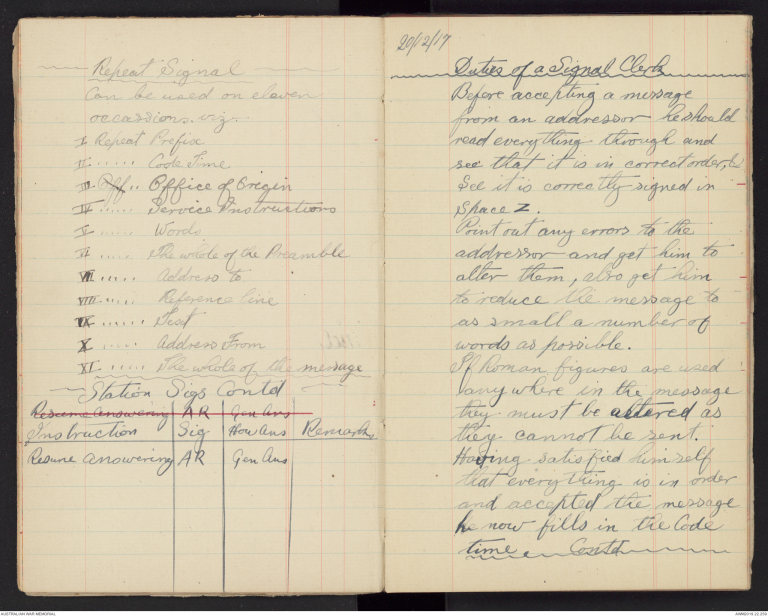
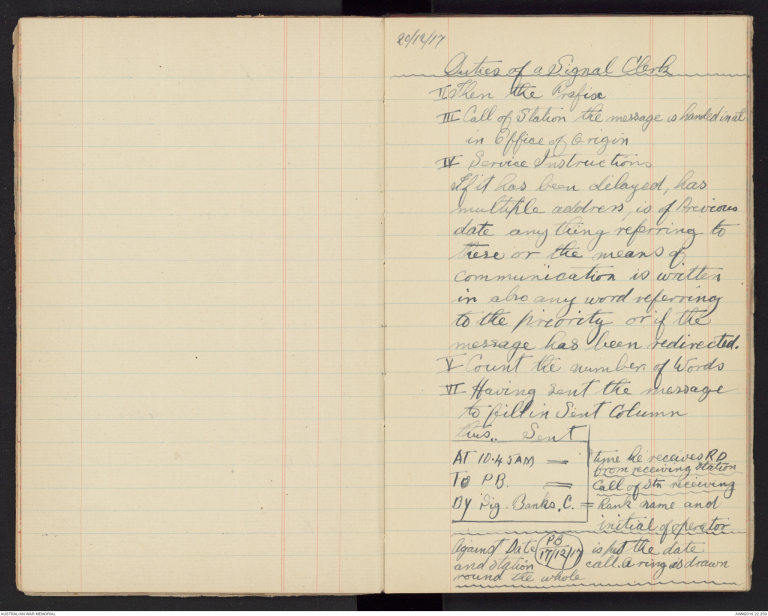
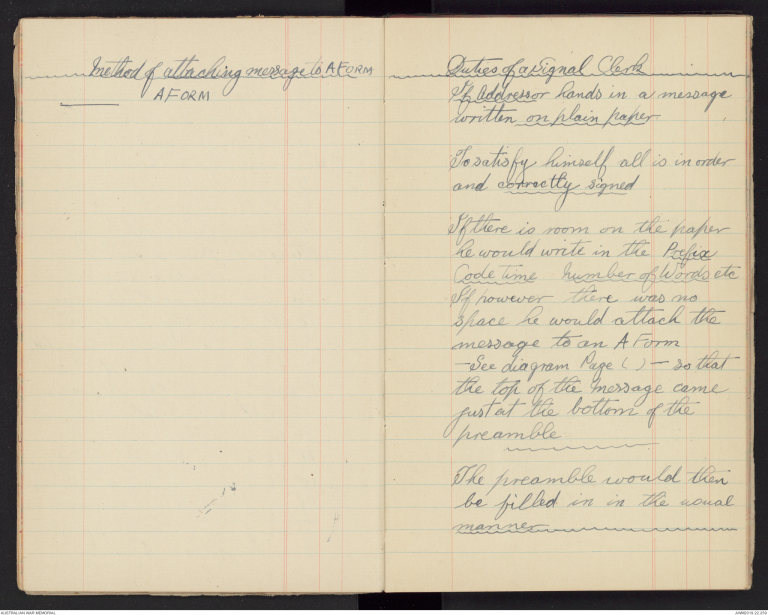
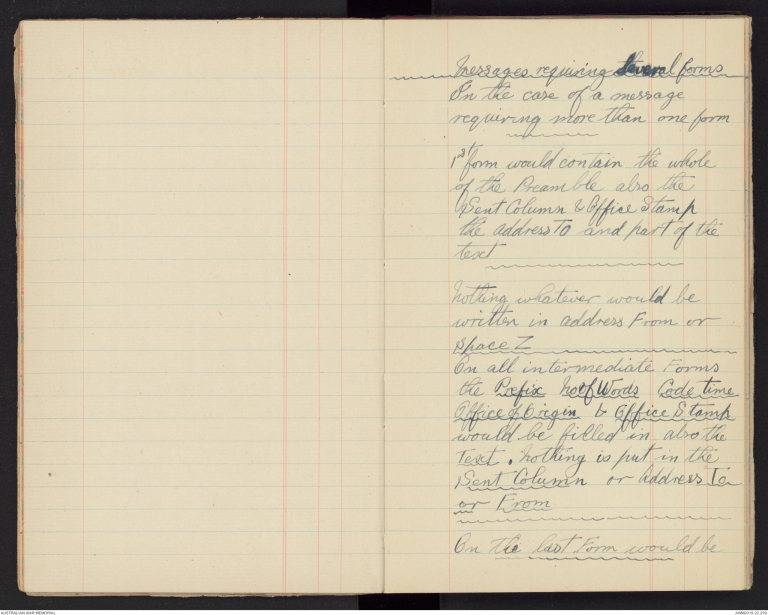
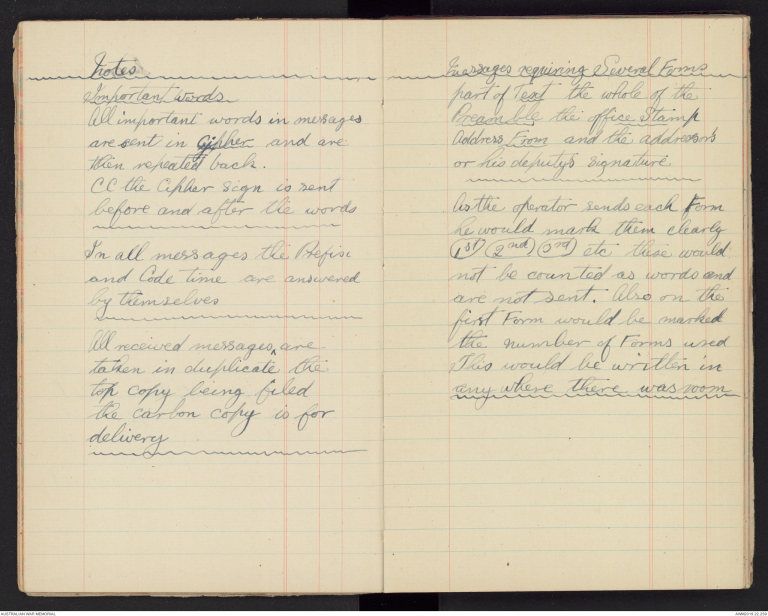
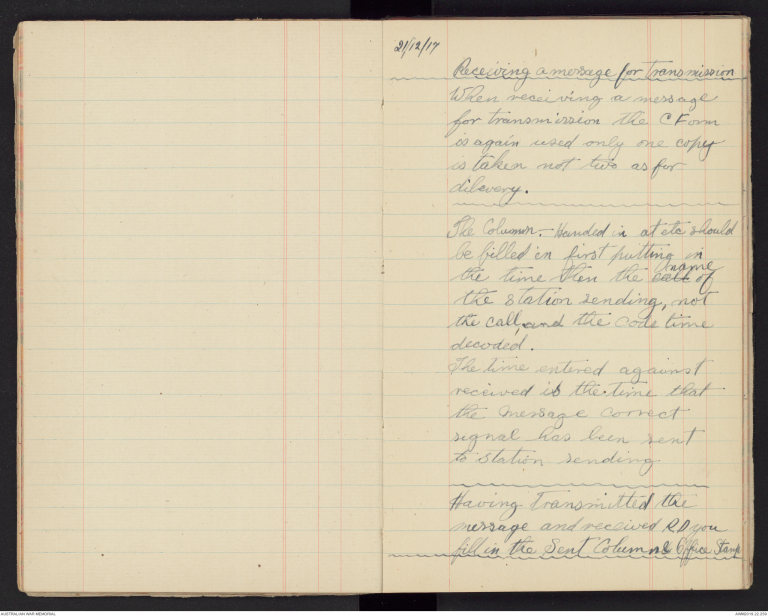
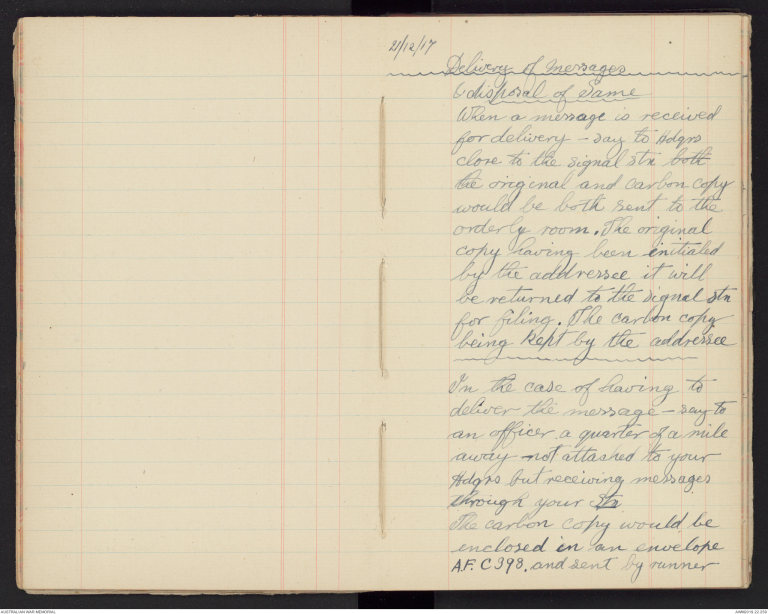
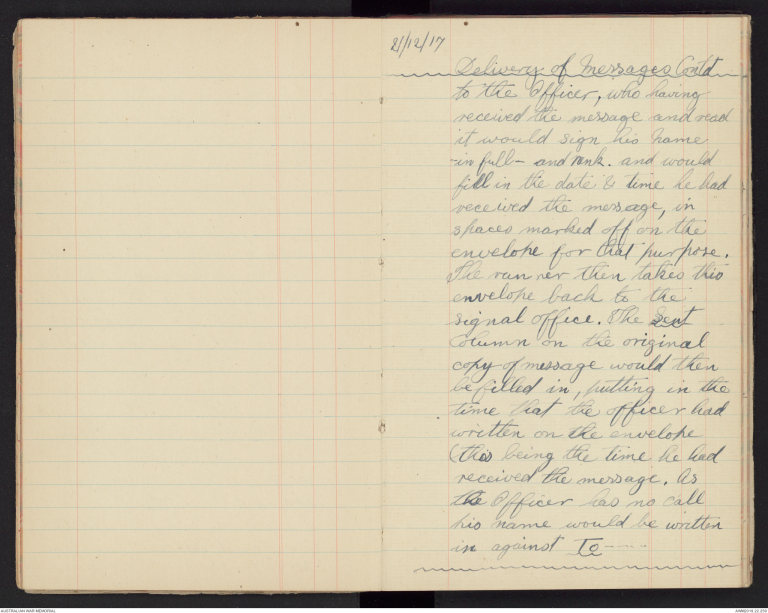
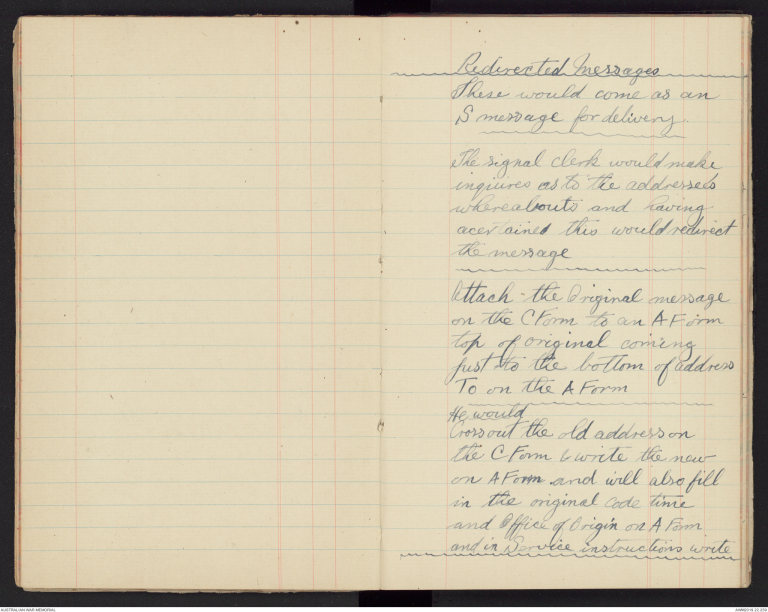
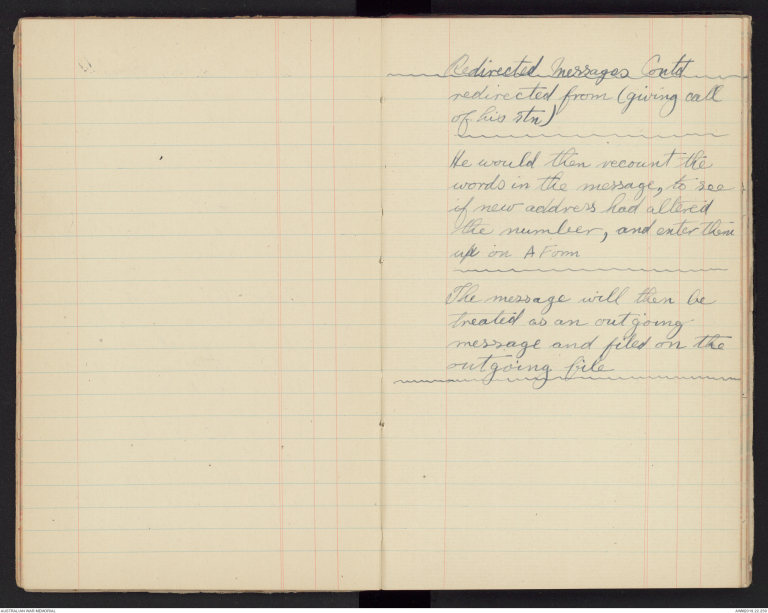
Repeat Signal
Can be used on eleven
occasions viz
I Repeat Prefix
II ....... Code Time
III xxx... Office of Origin
IV ...... Service Instructions
V ...... Words
VI ....... The wrole of the Preamble
VII ...... Address to
VIII ...... Reference line
IX ..... Text
X ..... Address From
XI ..... The wrole of the message
Station Sigs Contd
Resume Answering AR Gen Ans
Instruction Sig How Ans Remarks
Resume Answering AR Gen Ans
20/12/17
Duties of a Signal Clerk
Before accepting a message
from an addressor he should
read everything through and
see that it is in correct order, to
see it is correctly signed in
space Z.
Point out any errors to the
addressor and get him to
alter them, also get him
to reduce the message to
as small a number of
words as possible.
If Roman figures are used
any where in the message
they must be altered as
they cannot be sent.
Having satisfied himself
that everything is in order
and accepted the message
he now fills in the Code
time. Contd
20/12/17
Duties of a Signal Clerk
II Then the Prefix
III Call of Station the message is handed in at
in Office of Origin
IV Service Instructions
If it has been delayed, has
multiple address, is of Previous
date anything referring to
these or the means of
communication is written
in also any word referring
to the priority or if the
message has been redirected.
V Count the number of Words
VI Having sent the message
to fill in Sent Column
[[Plus?]] Sent.
At 10.45 AM = time he receives R D
from receiving station
To P B. = Call of Stn recieving
By Sig Banks. C. = Rank name and
initial of operator
Against Date PB/ 17/12/17 is put the date
and station call.A ring is drawn
round the whole
Method of attaching message to A Form
A Form
Duties of a Signal Clerk
If addressor hands in a message
written on plain paper
To satisfy himself all is in order
and correctly signed
If there is room on the paper
he would write on the Prefix
Code time Number of words etc
If however there was no
space he would attach the
message to an A Form
— See diagram Page ( ) — so that
the top of the message came
just at the bottom of the
preamble.
The preamble would then
be filled in in the usual
manner.
Messages requiring several 2 forms
In the case of a message
requiring more than one form
1st form would contain the whole
of the Preamble also the
Sent Column & Office Stamp
the address To and part of the
text
Nothing whatever would be
written in address From or
Space Z
On all intermediate Forms
the Prefix No of Words Code time
Office of Origin & Office Stamp
would be filled in also the
text. Nothing is put in the
Sent Column of Address To
or From
On the last form would be
Notes
Important words
All important words in messages
are sent in Cipher and are
then repeated back.
C C the cipher sign is sent
before and after the words
In all messages the [[?]]
and code time are answered
by themselves
All received messages are
to then in duplicate the
top copy being filed
the carbon copy is for
delivery
Messages requiring Several Forms
Part of Text the whole of the
[[preamble?]] the office Stamp
address From and the addresser's
or his deputy's signature
As the operator sends each Form
he would mark them clearly
1st 2nd 3rd etc these would
not be counted as words and
are not sent. Also on the
first Form would be marked
the number of Forms used
This would be written in
anywhere there was room.
21/12/17
Receiving a message for Transmission
When receiving a message
for transmission the C Form
is again used only one copy
is taken not two as for
delivery.
The column-Handed in at etc should
be filled in first putting in
the time then the callname of
the ststion sending, not
the call, and the code time
decoded.
The time entered against
received is the time that
the message correct
signal has been sent
to station sending.
Having Transmitted the
message and received [[RD?]] you
fill in the sent Columns office stamp.
21/12/17
Delivery of messages and disposal of same
When a message is received
for delivery- say to [[?]]
close to the signal stn both
the original and carbon copy
would be both sent to the
orderly room. The original
copy having been initialed
by the addressee it will
be returned to the signal stn
for filing. The carbon copy
being kept by the addressee.
In the case of having to
deliver the message- say to
an officer a quarter of a mile
away not [[?]] to your
[[Hdgrs?]] but receiving messages
through your stn.
The carbon copy would be
enclosed in an envelope
A.F.C398. and sent by runner
21/12/17
Delivery of messages Contd
to the officer, who having
received the message and read
it would sign his name
in full- and rank. and would
fill in the date & time he had
received the message, in
spaces marked off on the
envelope for that purpose.
The runner then takes this
envelope back to the
signal office. The Sent
column on the original
copy of message would then
be filled in, putting in the
time that the officer had
written on the envelope
this being the time he had
received the message. As
the officer has no call
his name would be written
in against To
Redirected message
These would come as an
S message for delivery
The signal clerk would make
inquires as to the addressee's
whereabouts and having
acertained this would redirect
the message
Attach the original message
on the C Form to an A Form
top of original coming
just to the bottom of address
To on the A Form
He would cross out the old address on
the C Form & write the new
on A Form and will also fill
in the original code time
and office of origin on A Form
and in Service instructions write
Redirected messages Contd
redirected from (giving call
of his stn)
He would then recount the
words in the message, to see
if new address's had altered
the number, and enter these
up on A Form
The message will then be
treated as an outgoing
message and filed on the
outgoing file
 Nathan
NathanThis transcription item is now locked to you for editing. To release the lock either Save your changes or Cancel.
This lock will be automatically released after 60 minutes of inactivity.